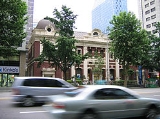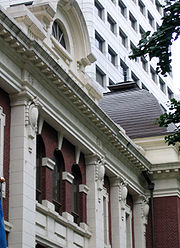
Gwangtonggwan
Encyclopedia
Gwangtonggwan located in Seoul, is one of Korea's oldest bank buildings. Its address is 19 Namdaemunno
1-ga, Jung-gu, Seoul
. Currently the Woori Bank
's Jongno
Branch, it is also the oldest continuously operating bank building in Korea
.
Constructed in 1909, Gwangtonggwan is one of the few surviving examples of Korea's early 20th century western architecture. In recognition of the building's architectural and historic importance, Gwangtonggwan was registered as the one of city's protected monuments on March 5, 2001.
. The construction of this building was finished on July, 1909.
However, a fire occurred on February, 1914, and the building's detail was much altered from its original form when it was restored and reopened in 1915. Since this building was located near Gwangtonggyo Bridge, a historic and important bridge of Seoul that crosses Cheonggyecheon
, it came to be called as "Gwangtonggwan." The Korean term "gyo (교; 橋)" translates in English as "bridge," while "gwan" (관; 館) translates as "building" or "house."
Following Japan's annexation of Korean Empire
in 1910, Cheon-il Bank changed its name to Joseon Sangup Bank in 1911, and moved its head offices from Gwangtonggwan to a different location in 1924. The building therefore became the Sangup Bank's Jongno branch on August 31, 1924.
Joseon Sangup bank changed its name to Hanguk Sangup Bank (also known as Commercial Bank of Korea) when Korea was liberated, changed its name to Hanbit Bank in 1998, and then again to Woori Bank
in 2002, but Gwangtonggwan still maintains and continues its banking operations as a Jongno branch.
 Mainly built from red bricks and granite, the Gwangtonggwan building has a symmetrical layout which roughly covers 774 square meters. The first floor of this building was designed and served as a bank, while the second floor was designed for conference rooms and offices.
Mainly built from red bricks and granite, the Gwangtonggwan building has a symmetrical layout which roughly covers 774 square meters. The first floor of this building was designed and served as a bank, while the second floor was designed for conference rooms and offices.
When it was originally constructed in 1909, the building had Ionic
pilasters, but during the reconstruction following the fire in 1914, the Ionic
capitals were removed and baroque decorations were added instead to the pilasters. Today's building has circular and arched windows, decorated pilasters, two baroque-styled domes with finial
s, two dormer windows, and a detailed pediment
consisting of a half-circular window.
Rejecting references to a traditional Korean architecture, the architects designed Gwangtonggwan in an eclectic and westernized style. The main entrance is flanked by two Tuscan
columns, and its entablature
bears an inscription, "朝鮮商業銀行鐘路支店" (조선상업은행 종로지점; Joseon Sangup Bank Jongno Branch), inscribed from right to left following the old Korean tradition of writing. Two other entrances on either side of the main entrance also are flanked by two Tuscan
columns, but are no longer used as entrances.
Namdaemunno
Namdaemunno is a major thoroughfare in the central districts of Seoul, South Korea and a two-way road consisting of 8 lanes. With a 2 km length and a 40∼50m width, Namdaemunno originates at Bosingak in Jongno-gu and terminates at Seoul Station in Jung-gu....
1-ga, Jung-gu, Seoul
Jung-gu, Seoul
Jung-gu is one of the 25 gu which make up the city of Seoul, South Korea. It is located on the north side of the Han River, and is the historical center of the city .-Overview:...
. Currently the Woori Bank
Woori Bank
Woori Bank is a bank headquartered in Seoul, Korea. The bank changed its name in 2002, and includes the former Commercial Bank of Korea, Hanil Bank, and Peace Bank. It was known from 1999 through 2002 as Hanvit Bank...
's Jongno
Jongno
Jongno is one of the oldest major east-west thoroughfares in central Seoul, South Korea, connecting Sejongno to Dongdaemun. It remains one of Seoul's most important financial and cultural areas to this day...
Branch, it is also the oldest continuously operating bank building in Korea
Korea
Korea ) is an East Asian geographic region that is currently divided into two separate sovereign states — North Korea and South Korea. Located on the Korean Peninsula, Korea is bordered by the People's Republic of China to the northwest, Russia to the northeast, and is separated from Japan to the...
.
Constructed in 1909, Gwangtonggwan is one of the few surviving examples of Korea's early 20th century western architecture. In recognition of the building's architectural and historic importance, Gwangtonggwan was registered as the one of city's protected monuments on March 5, 2001.
History
Gwangtonggwan was built in 1909 originally as a head office for Daehan Cheon-il Bank and Suhyeongjohap. Daehan Cheon-il Bank, established in 1899 and supported by the Emperor Gojong of the Korean Empire, was a Korean bank aimed to preserve Korea's national capital assets against the growing influences of the Japanese banks over Korea's finances. The building itself was designed by the architecture and construction office of the Takjibu, the Ministry of Finance of the Korean EmpireKorean Empire
The Greater Korean Empire was an empire of Korea that succeeded the Joseon Dynasty.In October 1897, Emperor Gojong proclaimed the new entity at Gyeongungung Palace and oversaw the partially successful modernization of the military, economy, land system, education system, and various industries...
. The construction of this building was finished on July, 1909.
However, a fire occurred on February, 1914, and the building's detail was much altered from its original form when it was restored and reopened in 1915. Since this building was located near Gwangtonggyo Bridge, a historic and important bridge of Seoul that crosses Cheonggyecheon
Cheonggyecheon
Cheonggyecheon is an 8.4 km long, modern public recreation space in downtown Seoul, South Korea. The massive urban renewal project is on the site of a stream that flowed before the rapid post-war economic development required it to be covered by transportation infrastructure...
, it came to be called as "Gwangtonggwan." The Korean term "gyo (교; 橋)" translates in English as "bridge," while "gwan" (관; 館) translates as "building" or "house."
Following Japan's annexation of Korean Empire
Korea under Japanese rule
Korea was under Japanese rule as part of Japan's 35-year imperialist expansion . Japanese rule ended in 1945 shortly after the Japanese defeat in World War II....
in 1910, Cheon-il Bank changed its name to Joseon Sangup Bank in 1911, and moved its head offices from Gwangtonggwan to a different location in 1924. The building therefore became the Sangup Bank's Jongno branch on August 31, 1924.
Joseon Sangup bank changed its name to Hanguk Sangup Bank (also known as Commercial Bank of Korea) when Korea was liberated, changed its name to Hanbit Bank in 1998, and then again to Woori Bank
Woori Bank
Woori Bank is a bank headquartered in Seoul, Korea. The bank changed its name in 2002, and includes the former Commercial Bank of Korea, Hanil Bank, and Peace Bank. It was known from 1999 through 2002 as Hanvit Bank...
in 2002, but Gwangtonggwan still maintains and continues its banking operations as a Jongno branch.
Architecture

When it was originally constructed in 1909, the building had Ionic
Ionic order
The Ionic order forms one of the three orders or organizational systems of classical architecture, the other two canonic orders being the Doric and the Corinthian...
pilasters, but during the reconstruction following the fire in 1914, the Ionic
Ionic order
The Ionic order forms one of the three orders or organizational systems of classical architecture, the other two canonic orders being the Doric and the Corinthian...
capitals were removed and baroque decorations were added instead to the pilasters. Today's building has circular and arched windows, decorated pilasters, two baroque-styled domes with finial
Finial
The finial is an architectural device, typically carved in stone and employed decoratively to emphasize the apex of a gable or any of various distinctive ornaments at the top, end, or corner of a building or structure. Smaller finials can be used as a decorative ornament on the ends of curtain rods...
s, two dormer windows, and a detailed pediment
Pediment
A pediment is a classical architectural element consisting of the triangular section found above the horizontal structure , typically supported by columns. The gable end of the pediment is surrounded by the cornice moulding...
consisting of a half-circular window.
Rejecting references to a traditional Korean architecture, the architects designed Gwangtonggwan in an eclectic and westernized style. The main entrance is flanked by two Tuscan
Tuscan order
Among canon of classical orders of classical architecture, the Tuscan order's place is due to the influence of the Italian Sebastiano Serlio, who meticulously described the five orders including a "Tuscan order", "the solidest and least ornate", in his fourth book of Regole generalii di...
columns, and its entablature
Entablature
An entablature refers to the superstructure of moldings and bands which lie horizontally above columns, resting on their capitals. Entablatures are major elements of classical architecture, and are commonly divided into the architrave , the frieze ,...
bears an inscription, "朝鮮商業銀行鐘路支店" (조선상업은행 종로지점; Joseon Sangup Bank Jongno Branch), inscribed from right to left following the old Korean tradition of writing. Two other entrances on either side of the main entrance also are flanked by two Tuscan
Tuscan order
Among canon of classical orders of classical architecture, the Tuscan order's place is due to the influence of the Italian Sebastiano Serlio, who meticulously described the five orders including a "Tuscan order", "the solidest and least ornate", in his fourth book of Regole generalii di...
columns, but are no longer used as entrances.

